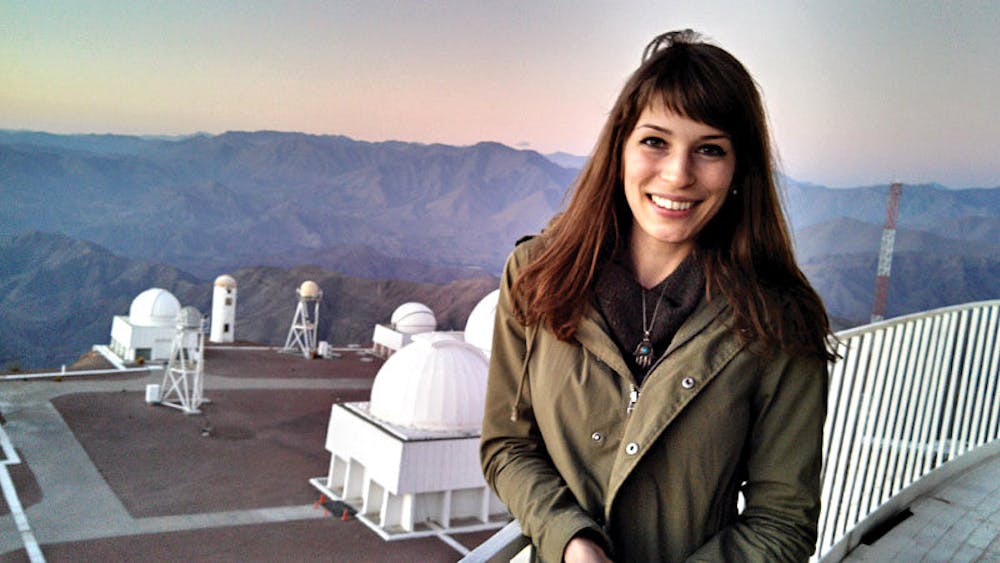This profile is part of a series focused on Brown faculty and students engaged in science and research, with the purpose of highlighting and making more accessible the work being pursued at all levels across disciplines.
Astrophysics has a “one-two punch” — it’s beautiful and it also lends itself to some of the deepest questions about the world, said Jacqueline McCleary GS.
McCleary, a fourth-year doctoral candidate in astrophysics, knew she wanted to study the subject “from the get-go.”
“I liked looking up at the night’s sky,” McCleary said, adding that she always wondered what the sky was made of, as a child.
Her parents supported her curiosity from an early age. During high school, her parents drove her to model rocket launches at the NASA Goddard Space Flight Center outside of Washington, where she was able to talk to astrophysicists.
McCleary went on to work at the center during the summers after her first and second undergraduate years.
“Up until that point, I had still sort of been on the outside of research, looking at pretty things, knowing that they exist, reading descriptions, but not really knowing how we arrived at that knowledge.” She added that she immediately fell in love with the research world.
The experience led McCleary to pursue research as an undergraduate at the University of Chicago and at the Harvard-Smithsonian Center for Astrophysics during subsequent summers.
But all of that work “is totally unrelated to the work I do now,” McCleary said. It wasn’t until the spring of her senior year that she became interested in the subfield of cosmology — her current line of work, McCleary said.
While taking an introductory course in cosmology during her senior year of college with astrophysicist Scott Dodelson, McCleary said she was so put off by some of the current theories in cosmology that she sent an email to Dodelson calling them “a steaming pile of BS.” She said she thought the concept of dark matter had been invented to explain aspects of the universe that scientists did not yet understand.
Dodelson called her, McCleary said, and described in depth the evidence showing the existence of dark matter and the reasons why astrophysicists think 95 percent of the universe’s mass energy is “dark.” That phone call “was a transformative experience for me,” McCleary said, adding that it inspired her to pursue cosmology research.
The composition of the universe is the “most fundamental” question, McCleary said, and it is the question on which cosmology research is centered.
McCleary specifically researches “dark matter substructure in galaxy clusters.”
“Galaxies tend to be social animals, and they tend to hang out in very large assemblies called clusters,” McCleary said. These clusters are so large that they “bend space-time,” and when light travels through the clusters, it bends too. When looking at a single galaxy, the bending effect is very small, but by looking at the distortions across a large number of galaxies, McCleary and other researchers can map the masses and locations of these clusters.
“We know that most of the matter from clusters of galaxies is dark,” McCleary said. This means that in studying these clusters, researchers are largely studying dark matter, she added.
McClearly said her work aims to test the theory that dark matter clusters grow larger over time rather than starting big and fragmenting.
Dark matter clusters are like cake batter, McCleary said. At first, they are very lumpy, but over time they become smooth.
In her research, McCleary examines galaxy clusters at various distances from Earth. Because light takes a long time to travel, light emitted from clusters farther from Earth is older than that from closer clusters.
If dark matter does indeed grow larger over time, closer galaxy clusters should be smoother than ones farther away. Through examining photographs of galaxies, McCleary looks “at light to see whether it supports this paradigm,” she said.
McCleary uses a telescope located at the Cerro Tololo Inter-American Observatory in La Serena, Chile, to acquire the super clear images she needs to conduct her work. She visits Chile about twice a year, spending about 20 hours traveling each way.
Last week, McCleary visited the telescope to take photographs of nearby galaxy clusters.
“It is a difficult process because the weather has to be beyond perfect, so if the weather isn’t perfect, you can fly as far as you want, but you have to wait for the sky conditions to be right.”
This time, “they were right,” McCleary said with a smile. “It was awesome.”
Due to an editing error, a previous version of this article incorrectly stated that McCleary’s parents drove her to model rocket launches at the NASA Goddard Space Flight Center once a month. In fact, the launches were once a month but McCleary attended infrequently. The Herald regrets the error.

ADVERTISEMENT
More




